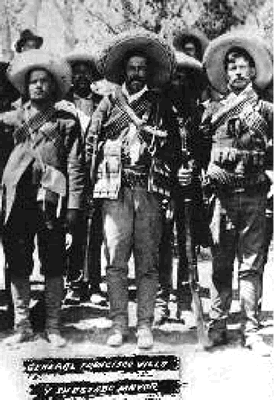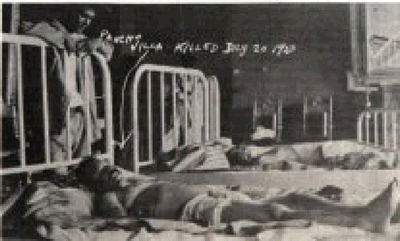PANCHO VILLA
The Assassination
The assassination of political leaders in Mexico during the
revolution was, unfortunately, becoming quite common. Between 1910 and 1920,
three of the biggest names of the Mexican Revolution; Madero, Zapata, and
Carranza, were assassinated. These leaders died because they were betrayed
by men the three thought they could trust.
Madero was always trustful of Huerta and his loyalty. Zapata was killed by
a trusted Carrancista officer who had promised to defect to Emiliano’s
side. Carranza was killed by a loyalist as he was fleeing the capital as he
was being overthrown.

Pancho Villa had grown up not trusting anyone, even his closest friends. Villa
would never allow anyone to walk behind him, even in his own house. Having
shot many men in his life as a bandit and during the revolution, Villa always
feared being shot himself. Following the revolution, he made a truce with
Obregon and agreed to settle down to a quiet life in Canutillo. However, he
never left Canutillo without an armed escort of at least 50 of his fierce
Dorado cavalry fighters.
Over the next couple of years, he became more comfortable with the Obregon
presidency and his feeling that the president would have him killed began
to ease. However, there was one man whom Villa feared would be the one to
kill him. Jesús Herrera, was the last male of the Herrera clan.
This was the family Villa had attempted to completely wipe out years earlier.
Since Jesús was the last of the Herrera family, Villa decided to go
after him. Villa hired several hit men, a Villista general and a colonel,
who were unsuccessful in their attempts to kill Herrera.
Herrera had been making public statements, telling Villa that, “If he
wanted peace of mind he would find it in an insane asylum." Herrera wrote
the newspaper and sated that, "this criminal has lost his mind, that
the whole country is full of the blood that this infamous bandit was shed.”
He compared Villa to ,”a savage beast shouting with pain and rage, anxiously
looking for anyone whom he should sully with his filthy spittle.”

Pancho Villa
Villa then decided to write Obregon and complain to him that Herrera had sent
killers after him but they had failed in their attempts. Obregon did nothing,
so Villa decided to start a media campaign and wrote letters to El Universal
newspaper in Canutillo. This was a bit unusual since Villa said he was trying
to lead a quiet private life.
Villa writing Obregon and asking for his help in stopping Herrera was also
strange in the fact that Obregon had defeated Villa at Celaya and they had
been enemies during the revolution. Either Villa figured Obregon saw the revolution
as something they were obliged to participate in, or Villa was naïve.
The latter is probably why Villa would even inform the president of assassination
attempts. Obregon finally did reply, three weeks later.
Obregon told Villa that the, “excessive obligations of his presidency,”
had caused the delay in his reply. In his response, Obregon also told Villa
that he would look for a, “discreet way,” to prevent the repetition
of such, “painful incidents.”
Within a short time, Herrera’s public attacks on Villa stopped. Historians
believe that Obregon had come up with a solution for the Herrera problem;
the assassination of Pancho Villa within three months of Villa’s letters
to Obregon.
In July 1923, Villa was making a trip by car to the village of Rio Florido,
where he would become the godfather of the child of a friend. The trip would
take about a day or so. Ever since he had moved to Canutillo, Villa never
went anywhere without his escort of his fifty guards. However, on this trip,
his secretary Trillo, told Villa that it was getting too expensive to constantly
take his entire escort. Villa agreed, and only took four men who could fit
in his car, alongside Villa, Trillo, and his driver. Villa had now fallen
in love with his automobile and loved to go riding.
Eventhough Herrera had stopped his public warnings to Villa, the former revolutionary
leader was still cautious. He ordered one of his Dorado leaders, Gil Piñon,
to send three heavily armed men from his escort to ride ahead to the outskirts
of Parral, to make sure the trip from his home in Canutillo would be safe.
Once he would arrive in Parral, he had no worries since there were hundreds
of federal troops under the command of his friend, Colonel Felix Lara.
As they drove through Parral, on July 10, neither Villa nor his four escorts
noticed that several rifles were aimed at him and his car from the windows
of an apartment at the corner of Benito Juarez and Gabino Barrera streets.
No shots were fired this day as when his car reached the intersection; hundreds
of kids ran out of a nearby school. The rifles were pulled back to wait for
another opportunity.
Then days later, on July 20, 1923, Villa was on his way back home after having
visited some friends and one of his former wives. Villa sent word to Lara
to send him three cheeses. This was code for the three-armed escorts who were
to meet Villa on the outskirts of Parral.
Unknown to Villa, was the fact that Lara and his men had left Parral that
same day. They had gone to the nearby town of Maturana to allegedly rehearse
for the Diez y Seis military parade, which was a Mexican national holiday.
This was a bit odd since the celebration was two months away. Villa may not
have continued his trip had he known Lara and his men were out of town. However,
as they drove into Parral, Villa was now at the wheel and in a good mood.
As he came up to the intersection of Benito Juarez and Gabino Barrera, a man
on the street raised his hand in salute and shouted out, “Viva Villa.”
A cry Villa had heard hundreds of times on the battlefield with his División
del Norte.

Pancho Villa's body after his assassination in 1923. No photo Credit Available
The famous battle cry for Villa was to now turn into a soliloquy for his death,
as the man’s raised hand was an apparent signal for the killers hidden
in an apartment, overlooking the Mexican hero. They opened fire when Villa’s
car reached the corner and slowed to make a turn.
Villa was hit nine times and was killed instantly. Also killed were Trillo,
the chauffeur and Villa’s assistant, Daniel Tamayo. Three members of
his escort were also hit. Two others began running, Ramon Contreras who was
badly wounded, managed to pull out his gun and kill one of the assassins before
he managed to escape. The other escort who ran was later cornered next to
a river and was shot and killed.
More than forty hollow-point bullets had hit Villa’s car. These bullets
expand after entering their target and shred the interior of the object or
person they enter. After making sure Villa was dead the killers casually rode
off on horseback.
The first report back to President Obregon was that Villa’s own men had
killed him. Obregon doubted this and told his staff and generals this. A few
hours later, Colonel Lara wired Obregon saying that about seven to nine armed
men, “apparently all of them rancheros,” had assassinated Villa.

A photo montage of Pancho Villa's corpse was put together by a seller of
postcards so that Americans could immerse themselves in morbid fantasies
of death over the demise of Villa. No photo Credit
Lara added, “the pursuit of these individuals is not possible, as you
wished and as I would have wished, since I had no horses that could be utilized
for that purpose.” This was not a very strong excuse since Parral was
filled with horses, and Lara could have easily have requisitioned them as
the garrison commander.
Obregon was suspicious of Lara’s reasoning, but never conducted any investigation
of his inaction and no type of action was ever conducted against Lara.
Word of Villa’s assassination quickly made it back to his home in Canutillo.
However, Obregon had ordered federal troops to Villa’s home to prevent
any type of reprisal. A standoff between the troops and Villa’s supporters
at the ranch lasted for about three days and eventually simmered out. The
troops stayed on for another ten days before pulling out without a fight.
Villa was buried the day after his death on Saturday, July 21, 1923. Thousands
of citizens from Parral followed his coffin to the cemetery, which was drawn
by two black horses. There was a military guard and a band, both of which
demonstrated the honor due him as a former general.
Sadly, none of Villa’s men or his closest friends were at his funeral.
They were at Canutillo, armed and ready for an attack by the government troops.
 Legends
Before the Revolution
Legends
Before the Revolution